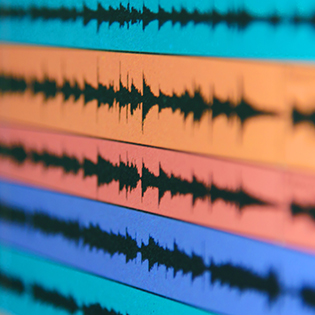
Developing a web app to facilitate ‘close listening’ of spoken performances of poetry.
Caroline Ardrey, University of Birmingham.
0000-0002-9971-9108

Non-academic collaborator on this research: Tom Cowley, Software Developer
When we study poetry in educational or academic settings, we typically emphasise close reading practices. Most people will be familiar with doing close readings of poems—a task which might involve annotating a text and discussing or writing about themes, images, form, sound patterns, rhyme scheme or other traits. Looking at these kinds of features helps us to draw meaning from a poem, and to piece together a response to a text.
Although the practice of reading ‘classic’ poetry aloud is much less common than it used to be, particularly within schools, the rise of slam in the UK, the USA and in France points to renewed interest in listening to poetry in performance. My own research into voice and performance began by examining French poetry performed as lyrics to popular songs, during my time as Research Associate on The Baudelaire Song Project. It was clear that experiencing poetry through the medium of song gave particular colour to the reception of a text, both as a result of musical features, and the specific qualities of voice and delivery. From this, it became clear that listening to poetry - spoken as well as sung - could offer new insights into the way in which poems are read and understood. Digital technology, meanwhile, offers opportunities for dynamic ways of visualising speech patterns, enabling non-specialist readers and listeners to conduct close listening of poetry for themselves.
Nineteenth-century poets such as Charles Baudelaire, Paul Verlaine and Arthur Rimbaud are prominent figures in the literary canon in France, and their work still features frequently as set texts on school and university curricula. In the 1950s and 1960s, spoken recordings of canonical poetry, delivered by professional actors were commonly broadcast on the radio, or recorded on vinyl, for educational purposes, and the aforementioned poets frequently featured amongst those performed.
Analysing spoken recordings of poems can offer new insights into the way in which poems are understood. Considering features such as intonation, accentual stress, and the handling of the particular conventions of syllabic patterns in French poetry has much to tell us about the way in which actors and producers themselves interpret famous poems. Close listening also shines a light on the interpretative biases which might, historically, have coloured young people’s experiences of poetry, as they listened to educational recordings at school or at home.
This research laid the foundations for developing a body of recordings of nineteenth-century French poetry for subjecting to close listening methods using digital tools. Together with software developer Tom Cowley, I created a digital web app to allow non-specialists to engage with the practice of close listening. The web app allows users to visualise emphasis, stress and the duration of syllables, as well as showing how different performers adhered to or deviated from standard conventions for pronouncing syllables when reading French poetry.
In future, this research aims to enable users to develop an even closer engagement with vocal production and with the act of performing poetry, by allowing individuals to record and analyse their own spoken performances of poetry, using our digital tools. Users will then be able to compare their ‘visualised voices’ with others’ performances, both amateur and professional. By encouraging non-academic audiences to pay closer attention to the role of voice in the performance of poetry, we can use digital tools to open up new ways of reading and understanding canonical works. The initiative aims, at its heart, to value poetry as a living and evolving entity, which is revived, reinvigorated and inscribed with new meaning through the act of performance.
Department / Institute / Centre
- Ardrey,C. ‘Visualising Voice: Analysing spoken recordings of nineteenth-century French poetry’, Digital Scholarship in the Humanities,